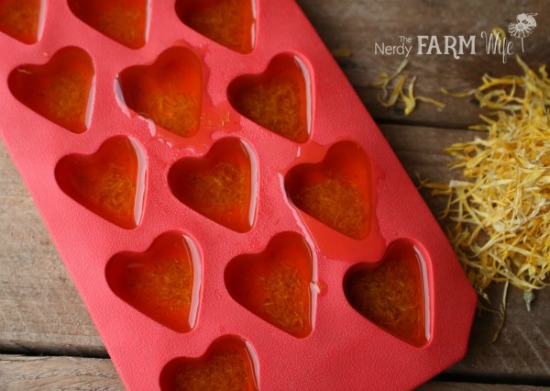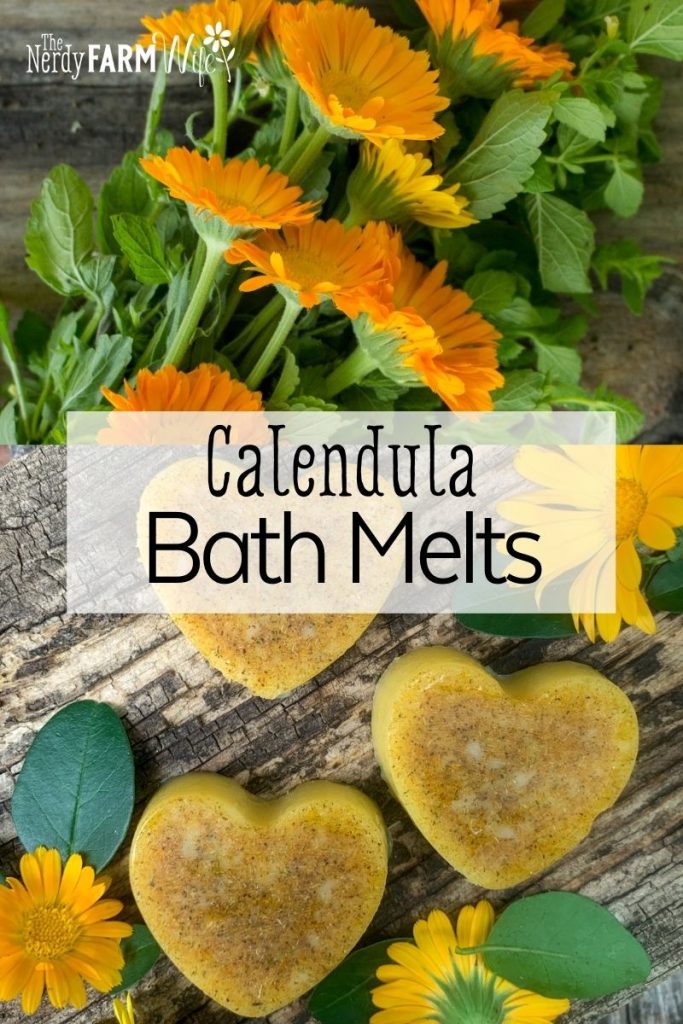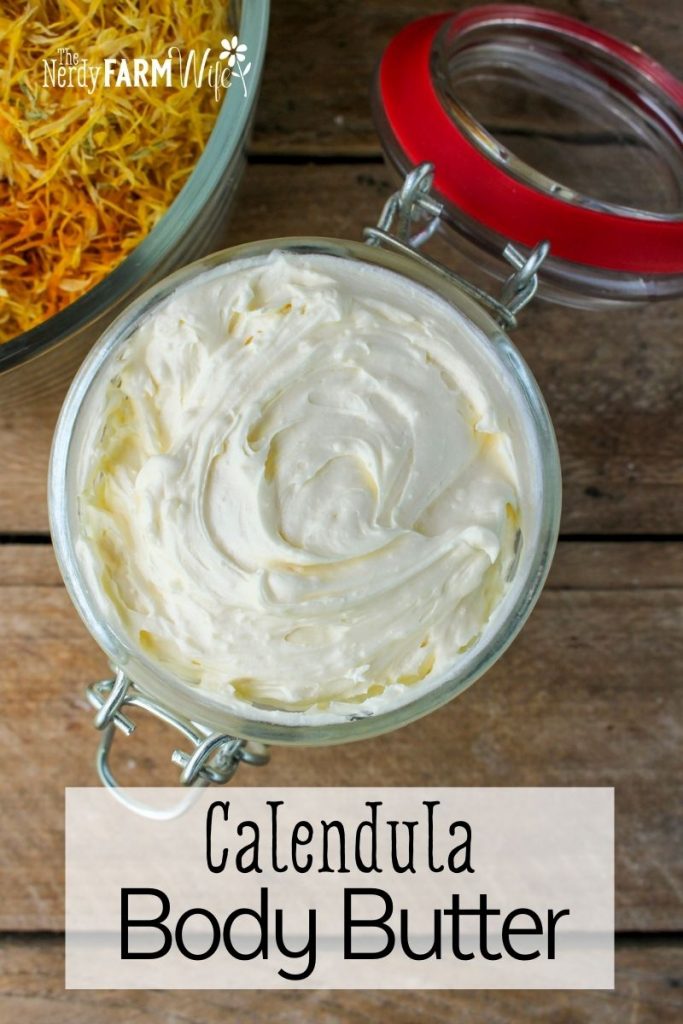Calendula Bath Melts + Body Butter Recipes
These recipes for skin soothing calendula bath melts and rich calendula body butter are perfect for dry skin in need of some TLC!
Their overlapping ingredient lists means you can also easily make them as a set, if you’d like.
Calendula Bath Melts
First up, are the bath melts and they are super easy to make!
You’ll need:
- 2 tablespoons dried calendula flowers
- 3.55 oz (100 g) mango (or shea) butter
- a few drops bergamot essential oil (or other favorite essential oil)
- a few drops of sea buckthorn oil (optional – gives the melts a more yellow color)
If you’re allergic to mango butter, you can use shea butter instead.
Tip: Basically, these bath melts are fancied up melted mango butter. So, if you don’t own a scale, you can kind of eyeball things and still create a nice product.

Step 1:
Using a coffee grinder, grind the calendula flowers to a fine powder. If needed, sift the powder so it’s very fine; you don’t want pieces of calendula floating in your tub.
You should end up with about 1 tablespoon of calendula powder, but around 2 teaspoons is fine too.
Step 2:
Weigh the mango (or shea) butter into a heatproof glass jar or upcycled tin can. Add the calendula powder.
Set the jar or can down into a small saucepan containing an inch or two of water. (This forms a double boiler of sorts.)
Place the pan over a medium-low burner and gently heat until the mango butter is completely melted. Remove from heat.
Step 3:
Stir in just a few drops of essential oil, to your scent preference. If you’d like your bath melts to have a yellow tint to them, add a few drops of sea buckthorn oil.
Stirring frequently so the powder is evenly distributed, pour the hot mixture into tiny candy molds or heatproof silicone molds.
It’s normal for the calendula powder to settle into the bottom of the mold. It results in a pretty yellow top on the finished bath melts when you unmold them.
Step 4:
Allow the bath melts to cool completely before removing from the mold. Unless your room temperature is cold, you will likely find it helpful to put the mold in the freezer for an hour or until the melts are firmed up enough to handle.
Turn the bath melts out onto wax paper and allow them to come to room temperature.
Store the bath melts in a cool place, or in very warm weather, your refrigerator.
To Use:
Drop one bath melt into your bath water as comfortably hot water runs into the tub. It will slowly melt as you take your bath, leaving a thin layer of butter over your skin and sealing in the moisture.
Be careful exiting the tub, as surfaces can get slippery from bath melts!
Calendula Body Butter
Next up is this decadent calendula body butter.
The recipe is loosely based off of and inspired by THIS ONE, found over at the Soap Queen blog.
To make it, you’ll need:
- 5.25 oz (150 grams) avocado butter or mango (or shea) butter
- 1.5 oz (45 grams) calendula infused oil (see my Calendula Oil & Salve Article for how to make) – be sure to use very light oils, such as rice bran, apricot kernel, grapeseed, fractionated coconut oil, jojoba, or argan oil to avoid a greasy feel in the final product
- 0.25 oz (7 grams) your favorite specialty or luxury oil (rosehip seed, argan, jojoba, kukui, etc) (OR more calendula infused oil)
- optional – a few drops of sea buckthorn oil for added natural yellow color
- optional – 1 tsp tapioca powder for a silkier, less-greasy feel (arrowroot may be substituted)
- optional – 10 to 30 drops of your favorite essential oil (I used bergamot essential oil & sweet orange for a sun-safe citrus scent)
Shea will make a richer heavier product, mango butter is a bit drier/less oily, and avocado butter is the lightest option of them all. Cocoa and kokum butter are too hard to use in this particular recipe.
I used calendula infused rice bran oil, since it has a light texture and absorbs easily. Other oil options include apricot kernel, grapeseed, fractionated coconut oil, jojoba, or argan oil. The type of oil you use will affect how quickly the butter sinks in. (Olive and avocado are heavier, sunflower is medium, apricot kernel and rice bran absorb quicker.)
What I love about this project is that no melting is involved. Because of that, it whips up super quick and easy!
Step 1:
Weigh out the mango (or other type) butter into a mixing bowl. Using a tall, narrow pitcher or bowl makes it easier to whip smaller amounts like this recipe calls for.
Using a hand or stand mixer, beat for several minutes, until the chunks are broken up and beginning to get smooth.
(It might seem a little difficult to mix mango butter at first, but as long as the chunks aren’t too large and your butter isn’t too hard it should soon soften up.)
Step 2:
Scrape down the sides of the bowl and add the rest of the ingredients.
Mix for several more minutes until the butter is light, fluffy and smooth, scraping the sides of the bowl occasionally as you go.
Test a small amount of the butter on your skin. If it feels light, smooth and silky, then it’s ready!
If you’re in a cooler climate, you may need to add a little more oil at a time until you get a nice fluffy texture.
If you’d like it to be a little bit more yellow, add a few drops more of sea buckthorn oil. (Be light handed though, it can stain your skin in high amounts!)
If you’d like more scent, add more essential oil, then mix a little more until everything is incorporated.
Step 3:
When it’s just right, spoon the body butter into jars. I found the 8-ounce one shown in the photo at my local craft store. You can also use wide-mouth canning jars (like THESE or THESE).
Or if you have the extra time, cover the mixing bowl overnight and whip it again the next day, adding a little more oil if needed – if it has turned hard overnight. The extra whipping will create an even lighter, fluffier textured body butter that can then be spooned into jars.
To use:
Body butter is very rich, so is often saved as a night-time treatment. Applying a small amount after a bath or shower helps seal in moisture.
I used bergaptene free bergamot and sweet orange essential oils, so the body butter would not contain photosynthesizers (essential oils which make your skin more sensitive to the sun.)
The shelf life of body butter is at least 6 to 9 months. If it deflates over time, you can whip it again with a hand mixer as needed.
Originally published April, 2016; updated for August, 2021.




That mango butter sounds so good. Maybe one day I will get into making things like that when my budget alows. Right now it is interesting to see how to make it.
Hi Betty! Mango butter is so nice – one of my favorites! I hope you’re able to get into making your own things soon! :)
Il love making soap
I think about it a lot during the day!! Research constantly!
I I want to make orange cream soap next!
Orange cream soap is on my want-to-make list too! :)
I’m looking forward to my calendula blooming this year! It self seeded wonderfully. I’m adding this to my to do list.
How wonderful! I love when my calendula self seeds too – such a beautiful & useful plant to have around! :)
I’ve been dying to try making bath melts and just keep putting it off. This recipe has convinced me to give it a go! Is there a particular way you need to package them once they’re done?
Hi Beth! I usually just gently stack them in a mason jar and keep them in a cool spot or in the summer, my fridge. Since we don’t have central air it gets pretty warm in the house!
The bath melts look fantastic! Looks like a great treat after a long day… I might try some lavender essential oil in a few for a bath before bedtime. Thanks for sharing! <3
Sounds like a great combination! Happy you like the recipe! :)
Hi Jan! Can the tapioca powder/arrowroot powder be substituted with bentonite clay? Or will that make the mixture extremely paste-like? Thanks and take care!
Hi Melanie! That’s a great question! I haven’t personally tried bentonite clay in body butter yet so I’m not positive what would happen. I have used a tiny pinch of rose and purple clays to add color to body butters and they do okay as long as I keep the amount very low (about 1/4 to 1/2 tsp in a batch).
So, I think you could put a small amount of bentonite, but it might color your body butter grayish, if your clay is gray (mine is, but I know it varies by supplier & batch).
Another option is to use cornstarch if you don’t have tapioca or arrowroot powder, or you could just leave that part out.
This recipe rocks, I went to the original Brambleberry post and like everyone else put on own spin on the lotion, but they were small changes, love this lotion, love, love, love this lotion! Thank You so much.
Hi Becky! That’s great to hear that you liked the recipe! Brambleberry has some terrific ideas! :)
Dear Jan,
I love bath melts, but have made some with cocoa butter (main ingredient) that have left yellow stains on my towels. I’m hoping this won’t happen with mango butter? Feeling a little gun-shy right now…
But thank you for these wonderful DIY recipes!
Hi Julia, So sorry to hear about the cocoa butter staining your towels! I haven’t noticed that with any of my bath melts so far, but have to confess that some of my towels are hand-me-downs from my grandmother (who passed away over a decade ago!) so I don’t always pay close attention to them. Mango butter is a nice white butter, but the calendula will turn it more golden. Perhaps you could have an old towel handy for the first try, just in case!